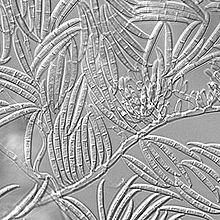- Gibberella zeae
-
Gibberella zeae Scientific classification Kingdom: Fungi Phylum: Ascomycota Class: Sordariomycetes Subclass: Hypocreomycetidae Order: Hypocreales Family: Nectriaceae Genus: Gibberella Species: G. zeae Binomial name Gibberella zeae
(Schwein.) Petch, (1936)Synonyms Botryosphaeria saubinetii
Dichomera saubinetii
Dothidea zeae
Fusarium graminearum
Fusarium roseum
Gibbera saubinetii
Gibberella roseum
Gibberella saubinetii
Sphaeria saubinetii
Sphaeria zeaeGibberella zeae, also known by the name of its anamorph Fusarium graminearum, is a plant pathogen which causes the wheat headblight disease. Fusarium head blight is a devastating disease on wheat and barley.[1] The pathogen is responsible for billions of dollars in economic losses worldwide each year.[2] Infection causes shifts in the amino acid composition of wheat.[3], results in shriveled kernels and contaminates the remaining grain with mycotoxins, mainly deoxynivalenol, which inhibits protein biosynthesis; and zearalenone, an estrogenic mycotoxin. These toxins cause vomiting, liver damage, and reproductive defects in livestock and are harmful to humans through contaminated food. Despite great efforts to find resistance genes against F. graminearum, no completely resistant variety is currently available. Research on the biology of F. graminearum is directed towards gaining insight into more details about the infection process and reveal weak spots in the life cycle of this pathogen in order to develop fungicides that can protect wheat from scab infection.
Contents
Life cycle
F. graminearum is a haploid homothallic ascomycete. The fruiting bodies called perithecia develop on the mycelium and give rise to ascospores, which land on susceptible parts of the host plant and germinate. The fungus causes head blight on wheat, barley, and other grass species as well as ear rot on corn. The primary inoculum are the ascospores, sexual spores which are produced in the perithecia.[4] Spores are forcibly discharged and can germinate within six hours upon landing on the plant surface. The scab disease is monocyclic; after one cycle of infection with ascospores, the fungus produces macroconidia by asexual reproduction.[5] These structures overwinter in the soil or in plant debris on the field and give rise to the mycelium in the next season.
Infection process
F. graminearum infects wheat spikes from anthesis through the soft dough stage of kernel development. The fungus enters the plant mostly through the flowers; however, the infection process is complex and the complete course of colonization of the host has not been described. [[Germ tubes seem not to be able to penetrate the hard, waxy surface of the lemma and palea which protect the flower. The fungus enters the plant through natural openings like stomates and needs soft tissue like the flowers, anthers and embryo to infect the plant.[6] From the infected floret, the fungus can grow through the rachis and cause severe damage in a short period of time under favorable conditions. Upon germination of the spores on the anthers and the surface of the developing kernel, hyphae penetrate the epicarp and spread through the seed coat. Successively, the different layers of the seed coat and finally the endosperm are colonized and killed.[7]
See also
- Fusarium graminearum genome database
External links
- Interactive Science Experiment Showcasing the Growth of Gibberella zeae (GCSE/A-level)
- Fusarium graminearum Database
- Index Fungorum
- USDA ARS Fungal Database
References
- ^ Bai G, Shaner G (2004):Management and resistance in wheat and barley to Fusarium head blight. Annual Review of Phytopathology 42: 135-161 [1]
- ^ De Wolf ED, Madden LV, Lipps PE (2003): Risk assessment models for wheat Fusarium head blight epidemics based on within-season weather data. Phytopathology 93: 428-435. [2]
- ^ Beyer M, Aumann J (2008): Effects of Fusarium infection on the amino acid composition of winter wheat grain. Food Chemistry 111: 750-754. [3]
- ^ Beyer M, Verreet J-A (2005): Germination of Gibberella zeae ascospores as affected by age of spores after discharge and environmental factors. European Journal of Plant Pathology 111: 381-389. [4]
- ^ Beyer M, Röding S, Ludewig A, Verreet J-A (2004): Germination and survival of Fusarium graminearum macroconidia as affected by environmental factors. Journal of Phytopathology 152: 92-97.[5]
- ^ Bushnell WR, Leonard KJ (2003): Fusarium head blight of wheat and barley.APS Press, St. Paul, Minnesota
- ^ Jansen C, Von Wettstein D, Schäfer W, Kogel K-H, Felk A, Maier FJ (2005): Infection patterns in barley and wheat spikes inoculated with wild-type and trichodiene synthase gene disrupted Fusarium graminearum. Proceedings of the National Academy of Sciences 102: 16892-16897 [6]
Categories:- Gibberella
- Plant pathogens and diseases
Wikimedia Foundation. 2010.


